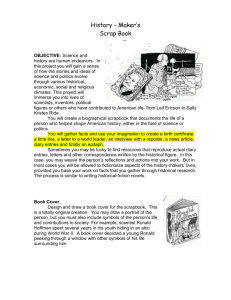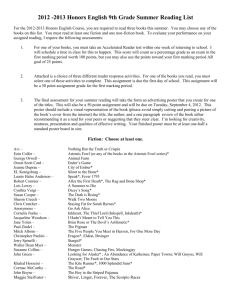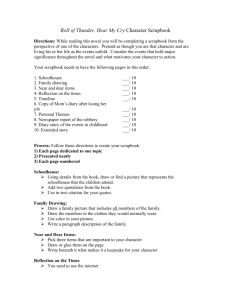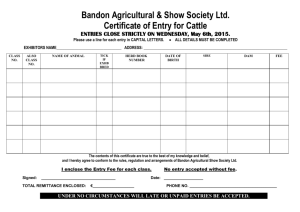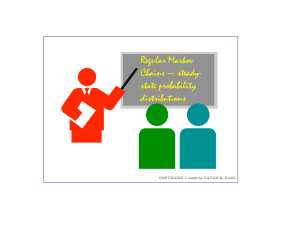History Maker Handout
advertisement
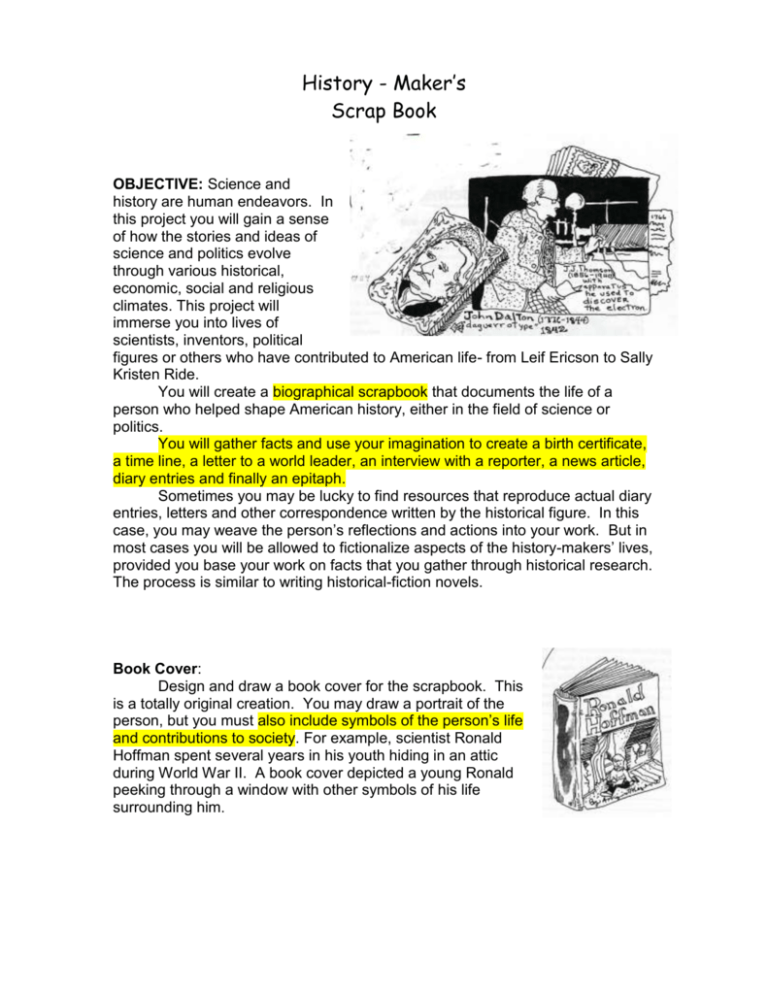
History - Maker’s Scrap Book OBJECTIVE: Science and history are human endeavors. In this project you will gain a sense of how the stories and ideas of science and politics evolve through various historical, economic, social and religious climates. This project will immerse you into lives of scientists, inventors, political figures or others who have contributed to American life- from Leif Ericson to Sally Kristen Ride. You will create a biographical scrapbook that documents the life of a person who helped shape American history, either in the field of science or politics. You will gather facts and use your imagination to create a birth certificate, a time line, a letter to a world leader, an interview with a reporter, a news article, diary entries and finally an epitaph. Sometimes you may be lucky to find resources that reproduce actual diary entries, letters and other correspondence written by the historical figure. In this case, you may weave the person’s reflections and actions into your work. But in most cases you will be allowed to fictionalize aspects of the history-makers’ lives, provided you base your work on facts that you gather through historical research. The process is similar to writing historical-fiction novels. Book Cover: Design and draw a book cover for the scrapbook. This is a totally original creation. You may draw a portrait of the person, but you must also include symbols of the person’s life and contributions to society. For example, scientist Ronald Hoffman spent several years in his youth hiding in an attic during World War II. A book cover depicted a young Ronald peeking through a window with other symbols of his life surrounding him. Birth Certificate: You may photocopy your own birth certificate and use it as a model for the historical figure’s certificate. For an “aged” certificate, pour about a cup of strong, cool tea into a large pan. Dip a blank piece of unlined paper into the pan for a few seconds, and dry it on several layers of paper towels or a flat rack, such as a cake rack or an oven rack. Use your best handwriting or calligraphy to write out the certificate. You may even want to add fingerprints, footprints or seals made of foil for greater “authenticity.” Diary Entries: Create three diary entries that represent various times in the history-maker’s life – youth, schooling, young adulthood, old age, etc. Research the history of the time in which the person lived and the accounts of her/his life through history books, biographies, autobiographies and other reference materials. Create the diary entries (minimum 6 expanded sentences) by basing them on important personal, scientific, and historical facts and events. You will imagine the figure’s voice and emotions. Time Line: A time line is a chronological depiction of important events. Books and encyclopedias will provide information about dates on birth, marriage, and death, in addition to important scientific or political advances or discoveries. You will create a hand written rough draft and type a final in computer class. It will be written in third person and in the present tense as if the events are unfolding as you read the timeline. The person’s contribution to history or science must be included in the timeline’s events. Letter to the President/World Leader: Write a letter to the President, Prime Minister, Monarch, etc, (choose one who served during the person’s career), explaining the importance of the scientist’s research or the politician’s contribution to culture and asking for funds or other help to support the work. This requires you to have an understanding of the nature of the person’s work or cause and to be able to justify its importance. You will need to find the residence of the world leader to include in the heading. Magazine Interview: Pretend that you are a reporter who has been assigned to interview the history-maker. Your article will be a dialogue between you, as the reporter, and the person, who describes his or her life’s work. Ask at least ten questions and determine the responses from your research. This will be published in a Q and A format and include a picture of the person. Newspaper Article: Choose a significant event in the figure’s professional life and write a news story about it. Answer the six basic questions of news: Who? What? Where? When? Why? How? Follow this with a description of the event and a summary of the person’s career. You may want to use a news article template or just use two columns in word. Epitaph: Create a poem, phrase, or use an actual quote from the person that epitomizes his or her life. This would be written on the gravestone as a tribute to the person after death. This is a way to reveal what you think is most significant after completing all your research and writing. Bibliography: Include a bibliography citing all the sources that you used to complete your scrapbook. You will use the format passed out and taught in class. A list of possible political subjects for the American History –Maker Scrap Book (this list is in no way complete) Christopher Columbus William Bradford Walter Raleigh Henry Hudson John Smith Massasoit Squanto Francis Drake Pocahontas Debohah Moody (Puritan turned Quaker) Phillis Wheatley (slave and poet) Olaudah Equiano Roger Williams Anne Hutchinson William Penn Ben Franklin James Oglethorpe Benjamin Benneker Eliza Lucas Patrick Henry George Washington King George III Paul Revere John Hancock John Adams Samuel Adams Thomas Jefferson Nathaniel Green John Paul Jones The Marquis de Lafayette General Charles Cornwallis Benedict Arnold Abigail Adams Martha Washington Deborah Sampson James Madison Dolley Madison James Monroe Alexander Hamilton Betsy Ross Daniel Boone Davy Crockett William Clark Meriwether Lewis Sacajawea Zebulon Pike Henry Clay Abraham Lincoln Andrew Jackson John J. Audubon Eli Whitney Narcissa Whitman Robert Fulton Marcus Whitman Lucy Applegate Harriet Tubman Sojourner Truth Robert E. Lee Jefferson Davies Frederick Douglass Ulysses S. Grant William Sherman Fr. Junipero Serra Pontiac American Scientists This is a partial list, if you find an American Scientist that is not included, please get permission to do your project on this person. Albert Abraham Michelson Alexander Graham Bell Alice Eastwood Annie Jump Cannon Barbara McClintock Benjamin Banneker Benjamin Franklin Billie L. Campbell Chien-Shiung Wu Daniel Hale Williams Dian Fossey Edward Mortley Edward Teller Edwin Powell Hubble Elizabeth Blackwell Ellen Henrietta Swallow Richards Emma Perry Carr Enrico Fermi Ernest Everett Just Ernest Orlando Lawrence Florence Bascom Florence Rena Sabin Garrett Augustus Morgan George Washington Carver Gertude Belle Elion Gerty Theresa Cori Gifford Pinchot Glenn Theodore Seaborg Grace Murray Hopper Helen Brooke Taussig Samuel F. B. Morse (Telegraph and Morse Code) Dr. Jonas Salk (Polio Vaccine) William Boeing Henry Ford (Assembly Line) Charles Goodyear (Rubber and Tires) Orville and Wilbur Wright Eli Whitney James Watson (Helped with DNA) Glenn Seaborg (Atomic Theory and Discovered 10 elements) Willis Carrier (Air Conditioning) Helen Sawyer Hogg Henrietta Swan Leavitt Ida Henrietta Hyde Jane Cooke Wright Jewel Plummer Cobb John Bardeen John Franklin Ender John Muir Josiah Gibbs Linus C. Pauling Lloyd Albert Quarterman Lloyd Augusts Hall Mae C. Jemison Margaret Mead Maria Geopart Mayer Maria Mitchell Mary Watson Whitney Melvin Calvin Percy Lavon Julian Rachel Carson Roger Randall Revelle Roger Tory Peterson Rosalyn Yalow Sally Kristen Ride Sylvia Earle Thomas Edison Thomas Hunt Morgan George Eastman (Camera) Dr. Percy Lavon Julian John Moses Browning First Due Date: Monday, February 25: Supplies including multi-color index cards (four colors), 1” view binder, four sources, including one book or long chapter/ article from a book, signed bottom of this letter. All other due dates are listed on the project management calendar that must be kept in the project binder. All due date changes will be recorded on the calendar by students at the teachers’ direction. Check the directions, the rubric which will be handed out later in the project, and the teachers’ individual directions for each section of the project. Do not begin the taught sections of the project until you have had the class with the specific format given and demonstrated by the teacher in charge of that section. Final Due Date: March 25 Scrapbook with rubric. Work o o o Days: Tuesday during Social Studies Thursday during Science. Halls of Fame Wednesday March 27 10:30 – 12:00. Much of the work will be completed at home after in-class instruction and work periods. ******************clip and return by February 22nd***************** Name: My history-maker: Questions about the project: Student Signature: Parent Signature:
